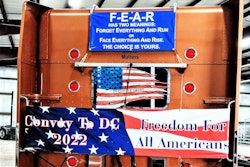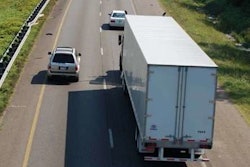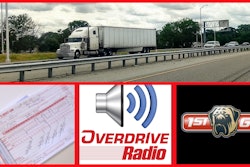The U.S. Environmental Protection Agency proposed on Monday new standards for heavy-duty truck and engine manufacturers to further reduce emissions starting in model year 2027.
EPA says the proposed standards would reduce emissions of smog- and soot-forming nitrogen oxides (NOx) from heavy-duty gasoline and diesel engines by as much as 60% by 2045 and set updated greenhouse gas (GHG) standards for certain commercial vehicle categories.
The proposal is part of the Biden Administration’s “Strengthening American Leadership in Clean Cars and Trucks,” and is the first step in EPA’s “Clean Trucks Plan.”
Specifics of the new regulations are still in development, and EPA is seeking comment from industry stakeholders on two regulatory options listed in the proposal. The agency notes that, while it is proposing two options, it is “giving full consideration to both options, as well as the full range of options between them." Both proposed options would begin with model year 2027 truck, but "Option 1 would have a second step” for 2031 vehicles.
Truck and Engine Manufacturers Association (EMA) President Jed Mandel said engines made after 2010 emit roughly 30 times less NOx than those made before 2010.
EPA also proposes an Alternative option, which is more stringent than the other two options and which the agency says may not be feasible in the proposed timeframe.

A big part of EPA’s proposal is a goal of maintaining emissions controls over a longer period of an engine’s operational life. To meet this goal, EPA is proposing, in part, to require manufacturers to extend the durability of their engines and emissions systems to make sure the engines will meet applicable emissions standards throughout their regulatory useful life.
[Related: Emissions system, while improved, still causing issues for some owners]
The agency is also proposing that manufacturers extend warranty periods for engines and emissions systems, which EPA hopes will result in better engine maintenance and less tampering with emissions controls.
“In addition, longer regulatory warranty periods may lead engine manufacturers to simplify repair processes and make them more aware of system defects that would be tracked and reported to EPA over a longer period,” the proposal added.
Under Option 1 of the proposal, model year 2027-2030 engines would have a 7-year, 450,000-mile warranty, and 2031 and later engines would have a 10-year, 600,000-mile warranty. Under Option 2, engines would have a 5-year, 350,000-mile warranty.
The Owner-Operator Independent Drivers Association said it believes there should have been more conversation with the trucking industry prior to this proposal, and that the proposed regulations would harm small-businesses in the industry.
“When the Cleaner Trucks Initiative was first announced in 2020, OOIDA stood side-by-side with EPA in hopes that a collaborative rulemaking process with input from professional truck drivers would result in practical emissions standards,” the group said in a statement. “Today’s announcement largely ignores that goal in favor of government overreach that will almost assuredly force safe drivers off the road, especially small-business truckers and owner-operators.”
The proposal resembles the California Air Resources Board’s Heavy-Duty Omnibus Regulation that was approved at the end of 2021 and takes effect with model year 2024 instead of EPA’s proposed model year 2027.
[Related: Are CARB's omnibus regulations too expensive?]
In addition to the proposed 2027-and-beyond regulations, EPA is also proposing to increase the stringency of the Phase 2 greenhouse gas emissions standards that were developed in 2016 for certain model year 2027 vehicles. The updated Phase 2 standards would apply to delivery trucks (box trucks and step vans), short-haul tractors, school buses and transit buses, which are already experiencing significant developments in electrification.
Mike Roeth, Executive Director of the North American Council for Freight Efficiency, said among the potential issues with the proposal is the compounding complexities of the engine and onboard technologies, which is likely to drive operational costs to skyrocket.
"Diesels are going to get more complex to handle NOx and more complex to meet demanding the Greenhouse Gas rule," he said. "More technology, more things to go wrong.”
EPA in its proposal outlined the estimated cost to manufacturers for the new technologies needed to meet the proposed standards. For a Class 8 diesel truck, EPA estimates an approximate $4,000 cost increase per vehicle. The agency notes, however, that it cannot estimate how manufacturers will translate those costs to the end user.
OOIDA noted how previous emissions regulations, while well-intentioned, missed the mark, especially early on, with breakdowns and other issues and urged EPA to work with the trucking industry to make sure these new standards meet their goals and don’t harm businesses.
“Make no mistake, clean air is a priority for everyone,” OOIDA said. “Truckers know this better than most folks, especially when they are having to pay over $5 a gallon [for fuel] in some places. However, we believe there is a more realistic path forward to reducing commercial vehicle emissions that actually involves listening to men and women in the trucking industry. ... Truckers know all too well from experience with previous rulemakings that poorly implemented regulations will result in breakdowns, downtime, and ultimately set back the goal of achieving cleaner air.”
The American Trucking Associations said it shares the goals of the Biden Administration to reduce air pollution and said it will work with regulators on the proposal.
“We will be looking very closely at the proposal put forth today by the administration, and working with them to shape an outcome that builds on those reductions, while not hurting the reliability of the trucks and trailers we purchase, nor imposing unreasonable or unworkable costs on our industry,” said ATA President and CEO Chris Spear.
Dave Heller, vice president of the Truckload Carriers Association, said his group is committed to working with the Biden Administration "in exploring the possibilities of utilizing proven emission reduction technologies to efficiently, effectively, and safely supply our nation with the goods it uses daily," he said. "We understand and appreciate the importance of reducing the pollutants caused by our industry but it must be done in a practical, unified manner with all parties involved."
The Diesel Technology Forum (DTF), a non-profit focused on raising awareness about the current and future role of diesel engines, agreed with OOIDA in that this proposal needs to be correct to meet its goals.
“For this proposed rule, it is vitally important that EPA get this right,” DTF said in a statement. “Diesel engines are going to continue to dominate many segments of the trucking sector for some time yet, even as alternative fuels and zero-emission vehicles become more available. The right rule will enable further improvements in diesel technology and continued investments in new vehicles that will be important to sustain progress toward meeting both clean air and climate goals. A rule that results in dramatic shifts in the new truck market (pre-buy/low-buy) will be bad for jobs, the economy and the environment.”
DTF added that, to meet climate objectives, truck owners “must be willing and able to invest in the next generation of advanced diesel products to emerge from these rules … Otherwise, without continued turnover in the fleet, older generations of technology with relatively higher emissions will stay in service longer, thereby delaying benefits to disadvantaged communities and contributing to worse air quality all around the country.”
The Forum noted that today, about half of registered commercial trucks are still pre-2011 model year trucks with older emissions systems.
Truck and Engine Manufacturers Association (EMA) President Jed Mandel noted that engines made after 2010 emit roughly 30 times less NOx than those made before 2010, "yet only about 50% of the fleet has turned over and realized the benefits of that modern technology that eliminates 98% of NOx and particulate matter emissions," he said. "It is imperative the new rule facilitate the transition to newer, cleaner trucks so we can achieve lower NOx emissions as soon as possible.”












